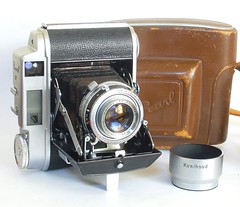Difference between revisions of "Pearl IV"
Rebollo fr (talk | contribs) m (internal links and minor detail) |
Hanskerensky (talk | contribs) m (→Links: Redirected Link URL to new site) |
||
| (43 intermediate revisions by 4 users not shown) | |||
| Line 1: | Line 1: | ||
| − | {{Japanese Semi postwar}} | + | {{Japanese Semi postwar |
| + | |image=[http://www.flickr.com/photos/32582084@N06/7594414740/in/pool-camerawiki/ http://farm8.staticflickr.com/7258/7594414740_6901041d3a_m.jpg]<br>''Pearl IV.<br>Image by {{image author|yalluflex}}. {{with permission}}'' | ||
| + | }} | ||
The '''Pearl IV''' is a 4.5×6cm folder, released by [[Konica|Konishiroku]] (the later Konica) in December 1958. It succeeded the [[Pearl (I), II and III|Pearl III]], and was the last of a long line of cameras called "Pearl", inaugurated in 1909. | The '''Pearl IV''' is a 4.5×6cm folder, released by [[Konica|Konishiroku]] (the later Konica) in December 1958. It succeeded the [[Pearl (I), II and III|Pearl III]], and was the last of a long line of cameras called "Pearl", inaugurated in 1909. | ||
| Line 5: | Line 7: | ||
== Description == | == Description == | ||
| − | The camera is a radical redesign of the [[Pearl (I), II and III|Pearl III]], with a completely different diecast aluminium body and a finder of advanced design with a projected frameline. The finder has additional lines for parallax but there is no automatic parallax correction: the frame does not move when focusing.< | + | The camera is a radical redesign of the [[Pearl (I), II and III|Pearl III]], with a completely different diecast aluminium body and a finder of advanced design with a projected frameline. The finder has additional lines for parallax but there is no automatic parallax correction: the frame does not move when focusing.<REF> The finder is sometimes described as having a frameline whose position adjusts to compensate for parallax. This is untrue: hold the camera steady, focus from the closest distance to infinity, and the view is unchanged and the frameline stays where it was. The frameline does have extra lines to indicate the variation caused by parallax: in this it is similar to some of the better accessory viewfinders (for 35mm rangefinder cameras, etc.) that lack an adjustment for distance. </REF> |
| − | + | {| class="plainlinks" align="center" style="text-align: center;" | |
| + | | [http://www.flickr.com/photos/camerawiki/46183240444/in/pool-camerawiki/ http://farm5.staticflickr.com/4820/46183240444_e2ea21e0c0_m_d.jpg] | ||
| + | |- | ||
| + | | ''Viewfinder and rangefinder. {{public domain Japan new}}'' | ||
| + | |} | ||
| − | + | The housing for the finders extends almost the whole way across the top. The eyepiece is offset to the left; the rangefinder second image window is surrounded by a rectangular frosted area for the illumination of the projected frame. The accessory shoe is above the centre of the top housing, which also has the name ''Pearl IV'' inscribed so as to be read when the camera is held vertically. | |
| + | |||
| + | The diecast body pushes the weight to 710g.<REF name="SK 01/59 p96"> Column in {{SK}} January 1959, p.96. </REF> The door over the bellows is hinged on the right hand side (as experienced by a photographer holding the camera horizontally), as opposed to the [[Pearl (I), II and III|Pearl III]] and all the earlier models. The shutter release is still at the top of the door and near the hinge, it is thus pressed by the right hand whereas the earlier models had a left-handed release button. It is supplemented by a thread for a cable release placed above the top housing next to the advance wheel. The front door itself is released by a small button at the front. | ||
| + | |||
| + | {| class="plainlinks" align="center" style="text-align: center;" | ||
| + | | [http://www.flickr.com/photos/camerawiki/33032998148/in/pool-camerawiki/ http://farm5.staticflickr.com/4876/33032998148_c51818b10c_m_d.jpg] | ||
| + | | [http://www.flickr.com/photos/camerawiki/45993786225/in/pool-camerawiki/ http://farm5.staticflickr.com/4878/45993786225_60b69bab0b_m_d.jpg] | ||
| + | |- | ||
| + | | ''Shutter release. {{public domain Japan new}}'' | ||
| + | | ''Film reminder. {{public domain Japan new}}'' | ||
| + | |} | ||
| + | |||
| + | The advance wheel is at the right end and has a film reminder at the top; there is double exposure prevention as well as an auto-stop mechanism. The exposure counter is placed next, and is automatically reset when the back door is opened. There is also a diamond-shaped indicator at the left end, confirming that the rollfilm leader paper is correctly engaged and the supply spool is actually turning. | ||
| + | |||
| + | {| class="plainlinks" align="center" style="text-align: center;" | ||
| + | | [http://www.flickr.com/photos/camerawiki/33033132448/in/pool-camerawiki/ http://farm8.staticflickr.com/7866/33033132448_9958d34924_m_d.jpg] | ||
| + | | [http://www.flickr.com/photos/camerawiki/33033159768/in/pool-camerawiki/ http://farm5.staticflickr.com/4909/33033159768_fb669840d0_m_d.jpg] | ||
| + | |- | ||
| + | | ''Advance indicator. {{public domain Japan new}}'' | ||
| + | | ''Exposure counter. {{public domain Japan new}}'' | ||
| + | |} | ||
| + | |||
| + | {| class="plainlinks floatright" width=120px style="text-align: center;" | ||
| + | | [http://www.flickr.com/photos/camerawiki/39948847973/in/pool-camerawiki/ http://farm8.staticflickr.com/7902/39948847973_82d83c5fc6_t_d.jpg] | ||
| + | |- | ||
| + | | ''Film loading. {{public domain Japan new}}'' | ||
| + | |} | ||
| + | |||
| + | The back is hinged to the right, and retained by a sliding bar on the left. The two spring-loaded flanges placed under the camera must be released before inserting the film spools. The position of the first exposure is set by aligning the start marks on the rollfilm paper backing with dots inside the camera. There is an internal lock, preventing accidental opening of the back before the end of the film roll.<REF name="SK 01/59 p96" /> The bottom plate has a tripod thread in the middle, and the body serial number engraved in small characters on the side. | ||
| + | |||
| + | The [[Hexar lenses|Hexar]] 75mm f/3.5 four-element lens and [[Seikosha-MX|Seikosha-MXL]] shutter are inherited from the [[Pearl (I), II and III|Pearl IIIL]], but the focusing aid is no longer convex but instead a simple tab. The camera cannot fold unless focused at infinity.<REF name="SK 01/59 p96" /> The shutter has B, 1–500 speeds, a self-timer, a built-in [[Light Value]] system and flash synchronization (M, F or X) via a PC socket. | ||
| + | |||
| + | {| class="plainlinks" align="center" style="text-align: center;" | ||
| + | | [http://www.flickr.com/photos/camerawiki/46188824594/in/pool-camerawiki/ http://farm5.staticflickr.com/4818/46188824594_6df5d1c3d9_m_d.jpg] [http://www.flickr.com/photos/camerawiki/46188841744/in/pool-camerawiki/ http://farm5.staticflickr.com/4835/46188841744_b4da83c996_m_d.jpg] | ||
| + | |- | ||
| + | | ''[[Hexar lenses|Hexar]] 75mm f/3.5 lens and [[Seikosha-MX|Seikosha-MXL]] shutter. {{public domain Japan new}}'' | ||
| + | |} | ||
== Commercial life == | == Commercial life == | ||
| − | + | {| class="plainlinks floatright" width=150px style="text-align: center;" | |
| + | | [http://www.flickr.com/photos/camerawiki/46188873904/in/pool-camerawiki/ http://farm5.staticflickr.com/4824/46188873904_e1ed671cce_m_d.jpg] | ||
| + | |- | ||
| + | | ''Announcement in {{SK}} January 1959. {{public domain Japan new}}'' | ||
| + | |} | ||
| + | |||
| + | The Pearl IV was released in December 1958.<REF> Miyazaki, ''Konika kamera no 50-nen'', p.129. </REF> It was featured and advertised in the January 1959 issue of most major Japanese photography magazines,<REF name="Kokusan p395"> {{Kokusan}}, p.395. </REF> such as {{SK}} whose extracts are reproduced in this page.<REF name="SK 01/59 p96" /><REF name="SK 01/59 p100"> Advertisement in {{SK}} January 1959, on the back cover. </REF><REF> See also the two-page advertisement in {{ACA}} January 1959, reproduced in {{Kokusan}}, p.266. </REF> | ||
| + | |||
| + | {| class="plainlinks" align="center" style="text-align: center;" | ||
| + | | [http://www.flickr.com/photos/camerawiki/46188917214/in/pool-camerawiki/ http://farm5.staticflickr.com/4836/46188917214_4ecb97e904_d.jpg] | ||
| + | |- | ||
| + | | ''Advertisement in {{SK}} January 1959. {{public domain Japan new}}'' | ||
| + | |} | ||
| + | |||
| + | The price was {{yen|22,000|1959}} (including ¥1,050 for the case),<REF name="SK 01/59 p96" /><REF name="SK 01/59 p100" /> making the IV slightly cheaper than the [[Pearl (I), II and III|IIIL]] (¥24,800). However, interest in folding cameras was waning fast and the model did not sell well.<REF> Miyazaki, ''Konika kamera no 50-nen'', p.130. </REF> The camera was only advertised for one month;<REF name="Kokusan p395" /> production stopped after about six months and after only about five thousand had been made.<REF> Miyazaki, ''Konika kamera no 50-nen'', pp.129–30; Tanaka, p.61 of {{KKS}} no.8; Hishida, p.73 of {{KKS}} no.10. </REF> | ||
| + | |||
| + | Body serial numbers are in the 80xxxx range, and probably started at 800001. The highest observed so far is 8004900,<REF> Example observed in an online auction. </REF> confirming the production estimate given in the written sources. All the lens numbers are in the 177xxxx range, but the lenses were not allotted to the camera bodies in strict ascending order. | ||
| + | |||
| + | {| class="plainlinks" align="center" style="text-align: center;" | ||
| + | | [http://www.flickr.com/photos/camerawiki/46913883691/in/pool-camerawiki/ http://farm8.staticflickr.com/7800/46913883691_1c7e002745_m_d.jpg] [http://www.flickr.com/photos/camerawiki/46861714362/in/pool-camerawiki/ http://farm5.staticflickr.com/4903/46861714362_23cf5414b3_m_d.jpg] [http://www.flickr.com/photos/camerawiki/33040418168/in/pool-camerawiki/ http://farm5.staticflickr.com/4892/33040418168_5c2578daca_m_d.jpg] [http://www.flickr.com/photos/camerawiki/31974601277/in/pool-camerawiki/ http://farm8.staticflickr.com/7893/31974601277_3d51a76ec9_m_d.jpg] | ||
| + | |- | ||
| + | | ''Pearl IV leaflet. {{public domain Japan new}}'' | ||
| + | |} | ||
| + | |||
| + | == Accessories == | ||
| + | The Pearl IV was sold in a blue and cream cardboard box, together with a brown leather ever-ready case, embossed ''Pearl'' at the front. A few accessories were available separately: the '''Konihood''' (コニフード) lens shade, '''Konifilter''' (コニフィルター) filters, '''Auto-Up''' (オートアップ) close-up attachments and '''Koniflash''' (コニフラシュ) flash gun. | ||
| + | |||
| + | {| class="plainlinks" align="center" style="text-align: center;" | ||
| + | | [http://www.flickr.com/photos/camerawiki/33040462478/in/pool-camerawiki/ http://farm5.staticflickr.com/4844/33040462478_f41924176b_m_d.jpg] | ||
| + | | [http://www.flickr.com/photos/camerawiki/33040484888/in/pool-camerawiki/ http://farm8.staticflickr.com/7903/33040484888_55d9c2f25a_m_d.jpg] | ||
| + | |- | ||
| + | | ''Konihood and Konifilters.<br>{{public domain Japan new}}'' | ||
| + | | ''Auto-Up and Koniflash.<br>{{public domain Japan new}}'' | ||
| + | |} | ||
| + | |||
| + | The lens shade was priced at ¥330.<REF name="leaflet Pearl IV"> Leaflet ''Sakura Products Semi-han supuringu kamera Pāru IV''. </REF> It is chrome-plated on the outside, with the name ''Konihood'' engraved in black. It is attached on the camera via a tightening screw on the side. Its optional brown leather case, marked ''KONIHOOD'', was priced at ¥230.<REF name="leaflet Pearl IV" /> Push-on Y0, Y1, Y2, R1 and P1 filters were available at ¥260 each.<REF name="leaflet Pearl IV" /> | ||
| + | |||
| + | The Auto-Up close-up attachments were manufactured by [[Pleasant]]. (Similar Auto-Up devices were supplied by the same company to many other camera makers.) They were available in two versions, priced at ¥1,930 each:<REF name="leaflet Pearl IV" /> Auto-Up No.1 is suitable for pictures from 1m to 50cm, and No.2 for pictures from 60cm to 43cm. | ||
| + | |||
| + | {| class="plainlinks" align="center" style="text-align: center;" | ||
| + | | [http://www.flickr.com/photos/camerawiki/46863759472/in/pool-camerawiki/ http://farm5.staticflickr.com/4871/46863759472_aac96a0867_m_d.jpg] [http://www.flickr.com/photos/camerawiki/31974674967/in/pool-camerawiki/ http://farm8.staticflickr.com/7922/31974674967_275908f84e_m_d.jpg] | ||
| + | |- | ||
| + | | ''Pleasant Auto-Up No.1 and No.2, for Pearl IV.<br>Pictures courtesy of [http://www.pacificrimcamera.com/ Pacific Rim Camera]. {{with permission}}'' | ||
| + | |} | ||
| + | |||
| + | The Auto-Up is made of two parts connected by a rigid chrome bar. The main optical element is attached to the lens rim by a tightening screw on the side. The other part consists of a large rectangular optical element placing itself in front of the camera's viewfinder, correcting parallax and rangefinder coincidence. This optical element is surrounded by a black frame, with the name ''AUTO–UP'' engraved in white, whereas the connecting bar is engraved ''PEARL IV No.1'' or ''No.2''. The name ''PLEASANT AUTO–UP I'' or ''II'' is repeated on the front rim, together with the distance range and ''PATENT 174601''. The device was sold in a blue cardboard box. It seems that it was supplied with a brown leather pouch, embossed ''AUTO–UP for Konica''. | ||
| + | |||
| + | Finally the flash gun advertised with the Pearl IV was a regular fan-shaped unit taking magnesium bulbs, priced at ¥1,950.<REF name="leaflet Pearl IV" /> It is unclear if it was called '''Koniflash II''' or '''Koniflash III'''.<REF> The two names are given in the leaflet ''Sakura Products Semi-han supuringu kamera Pāru IV''. </REF> | ||
== Posterity == | == Posterity == | ||
| + | |||
The Pearl IV is now regarded as one of the finest cameras of this format. Konishiroku would never again attempt anything like it (or reuse the name "Pearl"). The closest thing to a successor is probably the [[Fujica GS645]] of 1983. | The Pearl IV is now regarded as one of the finest cameras of this format. Konishiroku would never again attempt anything like it (or reuse the name "Pearl"). The closest thing to a successor is probably the [[Fujica GS645]] of 1983. | ||
| Line 20: | Line 110: | ||
Konishiroku's next medium-format rangefinder would be the [[Koni-Omega|Koni-Omega Rapid]] of 1964; Konishiroku also made an abortive attempt at another 4.5×6 camera with the [[Konica SF]] SLR. | Konishiroku's next medium-format rangefinder would be the [[Koni-Omega|Koni-Omega Rapid]] of 1964; Konishiroku also made an abortive attempt at another 4.5×6 camera with the [[Konica SF]] SLR. | ||
| + | {| class="plainlinks" align="center" style="text-align: center;" | ||
| + | | [http://www.flickr.com/photos/32582084@N06/7594421640/in/pool-camerawiki/ http://farm9.staticflickr.com/8421/7594421640_989f78515e_m.jpg] [http://www.flickr.com/photos/32582084@N06/7594419354/in/pool-camerawiki/ http://farm9.staticflickr.com/8161/7594419354_e1ca814d59_m.jpg] [http://www.flickr.com/photos/32582084@N06/7594409402/in/pool-camerawiki/ http://farm9.staticflickr.com/8015/7594409402_f128aff21f_m.jpg] | ||
| + | |- | ||
| + | | [http://www.flickr.com/photos/32582084@N06/7594406628/in/pool-camerawiki/ http://farm8.staticflickr.com/7251/7594406628_a94cfc1dc4_m.jpg] [http://www.flickr.com/photos/32582084@N06/7594399310/in/pool-camerawiki/ http://farm8.staticflickr.com/7134/7594399310_bcfa1ab321_m.jpg] [http://www.flickr.com/photos/32582084@N06/7594417260/in/pool-camerawiki/ http://farm8.staticflickr.com/7252/7594417260_d27042d38f_m.jpg] | ||
| + | |- | ||
| + | | ''Pearl IV, 6x4,5cm, [[Seikosha]]-MXL shutter, Hexar f3,5/75mm lens.<br>Images by {{image author|yalluflex}}. {{with permission}}'' | ||
| + | |} | ||
== Notes == | == Notes == | ||
<references /> | <references /> | ||
| − | == | + | |
| + | == Bibliography == | ||
| + | === Original documents === | ||
| + | * [[Konica|Konishiroku Shashin Kōgyō]]. ''Sakura Products Semi-han supuringu kamera Pāru IV'' (Sakura Products セミ判スプリングカメラパールIV, Sakura Products: the Pearl IV, a 4.5×6cm folding camera). Leaflet published c.1958–9, date not indicated. Document reproduced in [https://www.flickr.com/photos/camerawiki/albums/72157712095881661/ this Flickr album] by Rebollo_fr. | ||
| + | * {{SK}}. Advertisement by [[Konica|Konishiroku Shashin Kōgyō]] in no.81, January 1959, back cover. | ||
| + | * {{SK}} no.81, January 1959. "News flash". P.96. | ||
| + | |||
| + | === Recent sources === | ||
* {{Showa10}} Item 1443. | * {{Showa10}} Item 1443. | ||
* ''Konika-Minoruta-ten'' (コニカミノルタ展, Konica Minolta exhibition). Exhibition catalogue. Tokyo: JCII Camera Museum, 2005. | * ''Konika-Minoruta-ten'' (コニカミノルタ展, Konica Minolta exhibition). Exhibition catalogue. Tokyo: JCII Camera Museum, 2005. | ||
| − | * {{KKS010}} | + | * Hishida Kōshirō (菱田耕四郎). "Konica history 10. Sengo no kamera." (Konica history 10. 戦後のカメラ. Postwar cameras.) {{KKS010}} Pp.60–75. |
* {{McKeown12}} P.544. | * {{McKeown12}} P.544. | ||
| − | * Miyazaki Shigemoto (宮崎繁幹). ''Konika kamera no 50nen: Konika I-gata kara Hekisā RF e'' (コニカカメラの50年:コニカI型からヘキサーRFへ, Fifty years of Konica cameras: From the Konica I to the Hexar RF). Tokyo: Asahi Sonorama, 2003. ISBN 4-257-12038-X. | + | * Miyazaki Shigemoto (宮崎繁幹). ''Konika kamera no 50nen: Konika I-gata kara Hekisā RF e'' (コニカカメラの50年:コニカI型からヘキサーRFへ, Fifty years of Konica cameras: From the Konica I to the Hexar RF). Tokyo: Asahi Sonorama, 2003. <nowiki>ISBN</nowiki> 4-257-12038-X. |
* ''Omoide no supuringu-kamera-ten'' (思い出のスプリングカメラ展, Exhibition of beloved self-erecting cameras). Tokyo: JCII Camera Museum, 1992. (Exhibition catalogue, no ISBN number.) P.18. | * ''Omoide no supuringu-kamera-ten'' (思い出のスプリングカメラ展, Exhibition of beloved self-erecting cameras). Tokyo: JCII Camera Museum, 1992. (Exhibition catalogue, no ISBN number.) P.18. | ||
| + | * {{Zukan}} Item 1392. | ||
* Tanaka Masao (田中政雄). "Nihon no supuringu-kamera: Konishiroku" (日本のスプリングカメラ Konishiroku,<!-- Yes, the name is written in roomazi --> The spring cameras of Japan: Konishiroku). {{KKS008}} Pp.58–61. | * Tanaka Masao (田中政雄). "Nihon no supuringu-kamera: Konishiroku" (日本のスプリングカメラ Konishiroku,<!-- Yes, the name is written in roomazi --> The spring cameras of Japan: Konishiroku). {{KKS008}} Pp.58–61. | ||
== Links == | == Links == | ||
In English: | In English: | ||
| − | * [http://www.cosmonet.org/camera/pearl_e.htm Pearl IV] at [http://www.cosmonet.org/camera/index_e.html The Classic Camera] | + | * [https://web.archive.org/web/20170609160112/http://www.cosmonet.org/camera/pearl_e.htm Pearl IV] at [https://web.archive.org/web/20170609131749/http://www.cosmonet.org/camera/index_e.html The Classic Camera] (archived) |
| − | * [ | + | * [https://www.leitz-auction.com/en/Konishiroko-Konica-Pearl-IV/AI-9-27076 Pearl IV], lot no.791 of the [https://www.leitz-auction.com/en/Cameras/Past-Auctions/Auction-9/ ninth Westlicht Photographica Auction], on 20 May 2006 |
In Japanese: | In Japanese: | ||
| − | * [http://www.cosmonet.org/camera/pearl.htm Pearl IV] at [http://www.cosmonet.org/camera/ | + | * [https://web.archive.org/web/20171208083214/http://www.cosmonet.org/camera/pearl.htm Pearl IV] at [https://web.archive.org/web/20171229015938/http://www.cosmonet.org/camera/index.html The Classic Camera] (archived) |
| − | * [http://www.hayatacamera.co.jp/ | + | * [http://www.hayatacamera.co.jp/monthlyphoto/200705/ Pearl IV] at [http://www.hayatacamera.co.jp/ Hayata Camera Laboratory] |
| − | * [ | + | *[https://kanscamera.ilma.cc/html/p248.html Pearl IV]: repair notes and sample pictures at [https://kanscamera.ilma.cc/index.html Kan's Room] |
| − | * [http://www.k3.dion.ne.jp/~kosaka/konica.html Pearl IV] | + | * [https://web.archive.org/web/20161221135418/http://www.k3.dion.ne.jp/~kosaka/konica.html Pearl IV] with other cameras at [https://web.archive.org/web/20161111064729/http://www.k3.dion.ne.jp/~kosaka/fotoaprt1.html Yume o hakobu shashinki] (archived at archive.org) |
* [http://ha1.seikyou.ne.jp/home/sarusuberi/konica.htm Pearl IV] within a Konica page at [http://ha1.seikyou.ne.jp/home/sarusuberi/ Sarusuberi] | * [http://ha1.seikyou.ne.jp/home/sarusuberi/konica.htm Pearl IV] within a Konica page at [http://ha1.seikyou.ne.jp/home/sarusuberi/ Sarusuberi] | ||
[[Category: Japanese 4.5x6 rangefinder folding]] | [[Category: Japanese 4.5x6 rangefinder folding]] | ||
| − | [[Category: Konica]] | + | [[Category: Konica|Pearl IV]] |
[[Category: P]] | [[Category: P]] | ||
Latest revision as of 08:17, 8 February 2024
The Pearl IV is a 4.5×6cm folder, released by Konishiroku (the later Konica) in December 1958. It succeeded the Pearl III, and was the last of a long line of cameras called "Pearl", inaugurated in 1909.
Other articles deal with the early Pearl for plates and rollfilm, the Pearl No.2, the self-erecting 6×9 Pearl, the Semi Pearl, the Pearl (I), II and III, and the Baby Pearl and Pearlette cameras.
Contents
Description
The camera is a radical redesign of the Pearl III, with a completely different diecast aluminium body and a finder of advanced design with a projected frameline. The finder has additional lines for parallax but there is no automatic parallax correction: the frame does not move when focusing.[1]
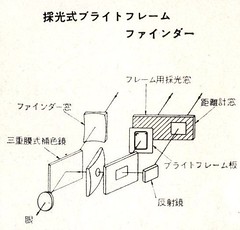
|
| Viewfinder and rangefinder. (Image rights) |
The housing for the finders extends almost the whole way across the top. The eyepiece is offset to the left; the rangefinder second image window is surrounded by a rectangular frosted area for the illumination of the projected frame. The accessory shoe is above the centre of the top housing, which also has the name Pearl IV inscribed so as to be read when the camera is held vertically.
The diecast body pushes the weight to 710g.[2] The door over the bellows is hinged on the right hand side (as experienced by a photographer holding the camera horizontally), as opposed to the Pearl III and all the earlier models. The shutter release is still at the top of the door and near the hinge, it is thus pressed by the right hand whereas the earlier models had a left-handed release button. It is supplemented by a thread for a cable release placed above the top housing next to the advance wheel. The front door itself is released by a small button at the front.
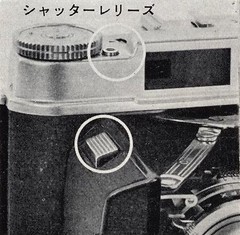
|
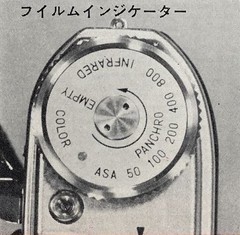
|
| Shutter release. (Image rights) | Film reminder. (Image rights) |
The advance wheel is at the right end and has a film reminder at the top; there is double exposure prevention as well as an auto-stop mechanism. The exposure counter is placed next, and is automatically reset when the back door is opened. There is also a diamond-shaped indicator at the left end, confirming that the rollfilm leader paper is correctly engaged and the supply spool is actually turning.

|
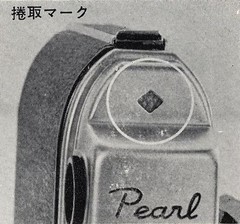
|
| Advance indicator. (Image rights) | Exposure counter. (Image rights) |

|
| Film loading. (Image rights) |
The back is hinged to the right, and retained by a sliding bar on the left. The two spring-loaded flanges placed under the camera must be released before inserting the film spools. The position of the first exposure is set by aligning the start marks on the rollfilm paper backing with dots inside the camera. There is an internal lock, preventing accidental opening of the back before the end of the film roll.[2] The bottom plate has a tripod thread in the middle, and the body serial number engraved in small characters on the side.
The Hexar 75mm f/3.5 four-element lens and Seikosha-MXL shutter are inherited from the Pearl IIIL, but the focusing aid is no longer convex but instead a simple tab. The camera cannot fold unless focused at infinity.[2] The shutter has B, 1–500 speeds, a self-timer, a built-in Light Value system and flash synchronization (M, F or X) via a PC socket.
 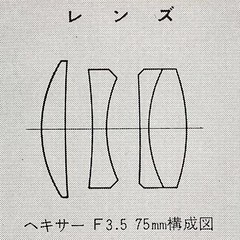
|
| Hexar 75mm f/3.5 lens and Seikosha-MXL shutter. (Image rights) |
Commercial life

|
| Announcement in Shashin Kōgyō January 1959. (Image rights) |
The Pearl IV was released in December 1958.[3] It was featured and advertised in the January 1959 issue of most major Japanese photography magazines,[4] such as Shashin Kōgyō whose extracts are reproduced in this page.[2][5][6]

|
| Advertisement in Shashin Kōgyō January 1959. (Image rights) |
The price was ¥22,000 (including ¥1,050 for the case),[2][5] making the IV slightly cheaper than the IIIL (¥24,800). However, interest in folding cameras was waning fast and the model did not sell well.[7] The camera was only advertised for one month;[4] production stopped after about six months and after only about five thousand had been made.[8]
Body serial numbers are in the 80xxxx range, and probably started at 800001. The highest observed so far is 8004900,[9] confirming the production estimate given in the written sources. All the lens numbers are in the 177xxxx range, but the lenses were not allotted to the camera bodies in strict ascending order.
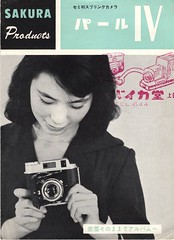 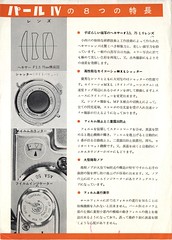 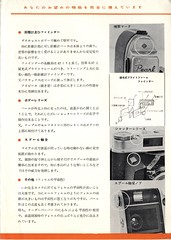 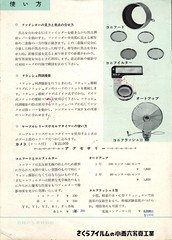
|
| Pearl IV leaflet. (Image rights) |
Accessories
The Pearl IV was sold in a blue and cream cardboard box, together with a brown leather ever-ready case, embossed Pearl at the front. A few accessories were available separately: the Konihood (コニフード) lens shade, Konifilter (コニフィルター) filters, Auto-Up (オートアップ) close-up attachments and Koniflash (コニフラシュ) flash gun.
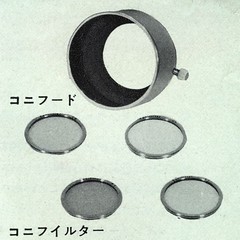
|

|
| Konihood and Konifilters. (Image rights) |
Auto-Up and Koniflash. (Image rights) |
The lens shade was priced at ¥330.[10] It is chrome-plated on the outside, with the name Konihood engraved in black. It is attached on the camera via a tightening screw on the side. Its optional brown leather case, marked KONIHOOD, was priced at ¥230.[10] Push-on Y0, Y1, Y2, R1 and P1 filters were available at ¥260 each.[10]
The Auto-Up close-up attachments were manufactured by Pleasant. (Similar Auto-Up devices were supplied by the same company to many other camera makers.) They were available in two versions, priced at ¥1,930 each:[10] Auto-Up No.1 is suitable for pictures from 1m to 50cm, and No.2 for pictures from 60cm to 43cm.
 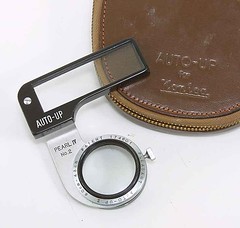
|
| Pleasant Auto-Up No.1 and No.2, for Pearl IV. Pictures courtesy of Pacific Rim Camera. (Image rights) |
The Auto-Up is made of two parts connected by a rigid chrome bar. The main optical element is attached to the lens rim by a tightening screw on the side. The other part consists of a large rectangular optical element placing itself in front of the camera's viewfinder, correcting parallax and rangefinder coincidence. This optical element is surrounded by a black frame, with the name AUTO–UP engraved in white, whereas the connecting bar is engraved PEARL IV No.1 or No.2. The name PLEASANT AUTO–UP I or II is repeated on the front rim, together with the distance range and PATENT 174601. The device was sold in a blue cardboard box. It seems that it was supplied with a brown leather pouch, embossed AUTO–UP for Konica.
Finally the flash gun advertised with the Pearl IV was a regular fan-shaped unit taking magnesium bulbs, priced at ¥1,950.[10] It is unclear if it was called Koniflash II or Koniflash III.[11]
Posterity
The Pearl IV is now regarded as one of the finest cameras of this format. Konishiroku would never again attempt anything like it (or reuse the name "Pearl"). The closest thing to a successor is probably the Fujica GS645 of 1983.
The Pearl IV is often referred to as a rarity. This is an exaggeration: five thousand is not so few, and it is not the kind of device that even the ignorant will unhesitatingly throw into the trash. Examples are not particularly hard to find in the Japanese market; however, they are expensive by folder standards, now (2006) costing around three times as much as examples of the Pearl III in similar condition.
Konishiroku's next medium-format rangefinder would be the Koni-Omega Rapid of 1964; Konishiroku also made an abortive attempt at another 4.5×6 camera with the Konica SF SLR.
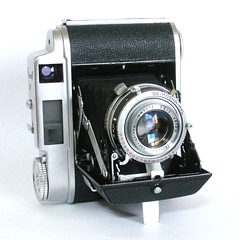 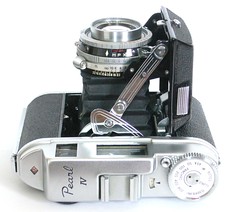 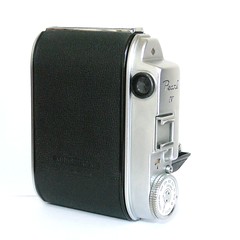
|
  
|
| Pearl IV, 6x4,5cm, Seikosha-MXL shutter, Hexar f3,5/75mm lens. Images by yalluflex. (Image rights) |
Notes
- ↑ The finder is sometimes described as having a frameline whose position adjusts to compensate for parallax. This is untrue: hold the camera steady, focus from the closest distance to infinity, and the view is unchanged and the frameline stays where it was. The frameline does have extra lines to indicate the variation caused by parallax: in this it is similar to some of the better accessory viewfinders (for 35mm rangefinder cameras, etc.) that lack an adjustment for distance.
- ↑ 2.0 2.1 2.2 2.3 2.4 Column in Shashin Kōgyō January 1959, p.96.
- ↑ Miyazaki, Konika kamera no 50-nen, p.129.
- ↑ 4.0 4.1 Kokusan kamera no rekishi, p.395.
- ↑ 5.0 5.1 Advertisement in Shashin Kōgyō January 1959, on the back cover.
- ↑ See also the two-page advertisement in Asahi Camera January 1959, reproduced in Kokusan kamera no rekishi, p.266.
- ↑ Miyazaki, Konika kamera no 50-nen, p.130.
- ↑ Miyazaki, Konika kamera no 50-nen, pp.129–30; Tanaka, p.61 of Kurashikku Kamera Senka no.8; Hishida, p.73 of Kurashikku Kamera Senka no.10.
- ↑ Example observed in an online auction.
- ↑ 10.0 10.1 10.2 10.3 10.4 Leaflet Sakura Products Semi-han supuringu kamera Pāru IV.
- ↑ The two names are given in the leaflet Sakura Products Semi-han supuringu kamera Pāru IV.
Bibliography
Original documents
- Konishiroku Shashin Kōgyō. Sakura Products Semi-han supuringu kamera Pāru IV (Sakura Products セミ判スプリングカメラパールIV, Sakura Products: the Pearl IV, a 4.5×6cm folding camera). Leaflet published c.1958–9, date not indicated. Document reproduced in this Flickr album by Rebollo_fr.
- Shashin Kōgyō. Advertisement by Konishiroku Shashin Kōgyō in no.81, January 1959, back cover.
- Shashin Kōgyō no.81, January 1959. "News flash". P.96.
Recent sources
- Asahi Camera (アサヒカメラ) editorial staff. Shōwa 10–40nen kōkoku ni miru kokusan kamera no rekishi (昭和10–40年広告にみる国産カメラの歴史, Japanese camera history as seen in advertisements, 1935–1965). Tokyo: Asahi Shinbunsha, 1994. ISBN 4-02-330312-7. Item 1443.
- Konika-Minoruta-ten (コニカミノルタ展, Konica Minolta exhibition). Exhibition catalogue. Tokyo: JCII Camera Museum, 2005.
- Hishida Kōshirō (菱田耕四郎). "Konica history 10. Sengo no kamera." (Konica history 10. 戦後のカメラ. Postwar cameras.) Kamera Rebyū: Kurashikku Kamera Senka (カメラレビュー クラシックカメラ専科) / Camera Review: All about Historical Cameras no.10, September 1987. No ISBN number. Konishiroku kamera no rekishi (小西六カメラの歴史, special issue on Konishiroku). Pp.60–75.
- McKeown, James M. and Joan C. McKeown's Price Guide to Antique and Classic Cameras, 12th Edition, 2005-2006. USA, Centennial Photo Service, 2004. ISBN 0-931838-40-1 (hardcover). ISBN 0-931838-41-X (softcover). P.544.
- Miyazaki Shigemoto (宮崎繁幹). Konika kamera no 50nen: Konika I-gata kara Hekisā RF e (コニカカメラの50年:コニカI型からヘキサーRFへ, Fifty years of Konica cameras: From the Konica I to the Hexar RF). Tokyo: Asahi Sonorama, 2003. ISBN 4-257-12038-X.
- Omoide no supuringu-kamera-ten (思い出のスプリングカメラ展, Exhibition of beloved self-erecting cameras). Tokyo: JCII Camera Museum, 1992. (Exhibition catalogue, no ISBN number.) P.18.
- Sugiyama, Kōichi (杉山浩一); Naoi, Hiroaki (直井浩明); Bullock, John R. The Collector's Guide to Japanese Cameras. 国産カメラ図鑑 (Kokusan kamera zukan). Tokyo: Asahi Sonorama, 1985. ISBN 4-257-03187-5. Item 1392.
- Tanaka Masao (田中政雄). "Nihon no supuringu-kamera: Konishiroku" (日本のスプリングカメラ Konishiroku, The spring cameras of Japan: Konishiroku). Kamera Rebyū: Kurashikku Kamera Senka (カメラレビュー クラシックカメラ専科) / Camera Review: All about Historical Cameras no.8, September 1986. No ISBN number. Supuringu kamera (スプリングカメラ, special issue on spring cameras). Pp.58–61.
Links
In English:
- Pearl IV at The Classic Camera (archived)
- Pearl IV, lot no.791 of the ninth Westlicht Photographica Auction, on 20 May 2006
In Japanese:
- Pearl IV at The Classic Camera (archived)
- Pearl IV at Hayata Camera Laboratory
- Pearl IV: repair notes and sample pictures at Kan's Room
- Pearl IV with other cameras at Yume o hakobu shashinki (archived at archive.org)
- Pearl IV within a Konica page at Sarusuberi
